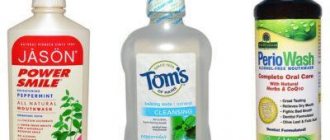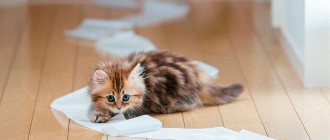Why is the smell so strong?
Fresh urine of kittens has almost no odor, but with the onset of puberty its chemical composition changes - hormones and felinin greatly enhance the amber.
Compared to cats, unneutered cats have three times more feline in their urine. This substance itself does not smell, but its breakdown products frankly stink. The chemical composition of urine is not constant; the smell is enhanced by many factors:
- the cat drinks little or endures it for a long time - concentration increases;
- kidney disease, bladder disease, urethritis, cystitis, genitourinary tract infections;
- with chronic stress and pain, the amber intensifies - this is a defensive reaction, this is how the pet calms itself;
- improper feeding - excess protein, metabolic disorders, a lot of fish in the diet, cheap “food” from the supermarket;
- sexual abstinence. Unlike dogs, it is not normal for cats to undergo sexual heat. When there is no partner, the body “floods” hormones to attract him.
Once the urine has been absorbed and dried, it is impossible to eliminate the lingering odor with just one cleaning. When uric acid crystals get wet, they begin to release odorous substances. It takes moisture out of the air, not to mention a new mark on top of the old one. To completely get rid of the smell of cat urine, you will have to wait for all its components to decompose or speed up this process with enzymes.
The nature of the appearance of the cat spirit
If you think that cat scents are the most complex and persistent of all existing animal odors, then this is another misconception. Cat urine is practically no different in composition from the secretions of other animals. It consists of the following components.
- urochrome;
- urea;
- uric acid.
Only in one case will the stench spread throughout the room and become ingrained - rarely cleaning up after your pet.
Professional help
Good store-bought products contain enzymes. Together with surfactants, enzymes decompose and do not mask the stench with fragrances. Natural ingredients are safer for animals and people, but chemistry works better. Fluorine and phosphates are undesirable in the composition.
Modern safe products with enzymes that help get rid of both the smell of cat urine and traces of vomit, excrement, and blood:
- Hartz Pet Stain & Odor Remover
- Just for Cats Urine Destroyer
- Urine Off cat and kitten
- Just for cats Stain & Odor Remover
- Odor Kill & Stain Remover
- Complete Pet Stain & Odor Remover
- Tri-bio, Odor gone, Odor kill
- Dezosan, Zoosan
It is important to distinguish products that eliminate stench from 2in1 repellent liquids - the latter are used precisely. If you flood your apartment with such a stain remover, you will most likely have the opposite effect. The cat will decide that he is being expelled from the territory and will generously move over the “enemy” scent.
Unlike ordinary household chemicals, enzymes work slowly - you need to leave the applied liquid for a while to react. The instructions indicate how to get rid of the smell of urine on a sofa, floor or carpet, whether a test is needed, precautions - for the best result, follow the manufacturer's recommendations.
Traditional methods
Household chemicals and available products help if used correctly. Before use, you need to do a test on an inconspicuous area to check how the substance acts on the surface being treated. Chlorine-containing cleaners should not be used - they frighten cats. With a high probability, the pet will deliberately flood this place to kill the smell of bleach.
Red pepper, mustard, mint, coffee, and aromatic oils are often recommended. All this smells nice, partially absorbs and masks the smell, but will not help get rid of the cat “scent” completely.
Proven urine decomposition methods:
- Mix highly carbonated mineral water with liquid soap 3k1, spray generously or pour over the stain, sprinkle with salt. Sweep away the salt after a couple of hours and vacuum;
- Generously treat the area with a saturated solution of potassium permanganate, wait 30 minutes, and rinse. It is a trouble-free oxidizing agent, but its coloring properties limit its application;
- lemon juice decomposes urea and scares the cat away from its favorite place. The juice must be freshly squeezed. You can leave citrus peels nearby;
- generously sprinkle the area with baking soda and pour in peroxide. When the hissing stops, remove the liquid and add baking soda again, filling it with peroxide. Leave for a couple of hours, remove with soapy water;
- Rub a piece of glycerin soap onto the moistened surface and leave for half an hour. If it is furniture or a porous wall, go over it with a brush. Rinse off by blotting with napkins;
- Vinegar 9% helps get rid of even the old smell of cat urine from the sofa, carpet, and porous walls. Spray with a spray bottle, wait 30 minutes, rinse with water and conditioner.
Iodine does a good job of eliminating any biological amber. It needs to be added to water, a teaspoon per liter. But iodine is a permanent color, so it is not suitable everywhere.
Vinegar, soda, peroxide
A scientific approach to eliminating the most persistent stench was proposed by an American chemist who was bothered by skunks.
The method works great on textiles and porous structures, decomposing absorbed urine:
- Blot the stain with napkins, trying to collect as much liquid as possible. You can fill it with filler, gently rub it over the surface, and remove it.
- Generously pour vinegar diluted with water 1k1. Waiting until it dries completely is important, otherwise the “aroma” will remain.
- Sprinkle with baking soda. If it sizzles, the vinegar has not dried. Remove the soda, add more vinegar and wait until dry.
- If it doesn’t sizzle, spray the soda with a previously prepared mixture. For 100 ml of hydrogen peroxide, half a teaspoon of dishwashing detergent. Spray until abundant foam appears, wait 2 hours.
- Clean with regular powder or a washing vacuum cleaner. Repeat if necessary.
The oxidation reaction decomposes the urine, the components evaporate along with a heavy, intensifying “aroma” - the room is immediately ventilated.
Treatment of different surfaces
The easiest way to deal with hard, non-absorbent surfaces is to collect the urine, wipe with an odor remover, and rinse with water.
But cats often choose less convenient places for marks and puddles:
| Surfaces | Description of processing |
| Wood, linoleum, walls and other porous surfaces | Blot with paper napkins, trying to collect as much moisture as possible. Spray generously and blot again. Spray, brush, collect moisture with napkins. |
| Cushioned furniture | Cat urine is removed from upholstery in the same way - with paper napkins, alternately spraying and collecting moisture. The solution is injected into mattresses and armrests with a syringe little by little in several places - if urine is absorbed, it is useless to wash it from the outside. |
| Carpet | Get wet and cover the stain with toilet filler for 20 minutes, preferably silica gel. The carpet is cleaned by driving in foam with a brush, being careful not to flood the surface. Excess moisture is removed immediately. The floor under the carpet must be washed and allowed to dry, otherwise the smell of cat urine will not get rid of. |
| Clothes, underwear | Before washing, the urine is washed off well under a directed stream - the item in the basin, the basin in the bath, with the stain under the running tap for 30 minutes. Machine wash, dry. If the smell persists, soak in vinegar for an hour and wash again. |
| Air | Boil water, add citrus pieces, walk around the room. Or place saucers with crushed garlic. An ozonizer will help get rid of the smell of cat urine in your apartment. Fresheners only mask the stench. |
If a cat goes to a flower instead of a tray, the plant is transplanted into new soil. The pot is soaked in water with vinegar or potassium permanganate for a day. If urine gets on the leaves, rinse the plant in the shower. The transplanted flower is placed in another place, preferably inaccessible to the cat. If this is not possible, cover the ground with a cut plastic plate or foil.
Shoes
Sneakers and slippers are washed under running water and washed in a machine.
Shoes that cannot be washed can only be saved without delay:
- Take out the insoles and wash them, or better yet buy new ones.
- Use a napkin to collect as much urine as possible.
- Pour in silica gel, wait half an hour, shake out.
- Fill it loosely with newspaper soaked in vinegar and leave it on the balcony for a day.
- Remove the newspaper, pour loose green tea inside, wait another day.
- Clean with shoe polish.
- If that doesn’t help, treat the inside with a professional urine odor remover, put it in a bag, and wait 2 hours.
- Rinse well.
There is no need to immediately fill your shoes with water - excess moisture will only wash the urine all over the shoe. The means at hand can ruin the item, so it’s better to take expensive shoes to the dry cleaner. Before you go anywhere in your cleaned shoes, you should walk around in them at home and check to see if the “aroma” returns after wearing them.
Tray
Often this is the only source of the unpleasant smell of cat urine in the apartment. To get rid of the stench, you need to use high-quality absorbents and remove dirty litter immediately. A scratched tray needs to be replaced - the damaged bottom absorbs uric acid. The carbon filter in the roof of the toilet house does a good job of trapping stinking components.
Wash the tray with neutral solutions without fragrances - a strong smell can scare away the pet, forcing it to relieve itself past the tray. Every day the container is rinsed with a shower over the toilet, using as hot water as possible. Potassium permanganate or antibacterial liquid soap is suitable for disinfection. But it is better to use special cleaners - Beekeeper, Faithful Friend, Nature's Miracle litter box.
How do you treat apartments to remove cat smells with dry fog?
Disinfectors have an unwritten rule: in order to completely neutralize, you must first find! Therefore, the work plan of professionals is always the same:
1. First of all, the disinfector determines the source of the “aroma” - be it the floor, the upholstery of the sofa, the wallpaper on the walls... To remove the smell of a cat, you need to know where it comes from, otherwise all efforts will be in vain.
2. Afterwards, the specialist treats the apartment with disinfectants - this is necessary in order to kill bacteria and possible infection.
3. Finally, the deodorization service sprays the preparations with a dry mist, which finally removes the odor and gives the room microclimate a truly pleasant aroma.
Naturally, we use exclusively modern means for disinfection and deodorization. They are non-toxic to humans, safe for animals, and do not in any way affect the well-being of indoor plants. Each drug is tested and approved for use in apartments and businesses; their high effectiveness has been proven over time. Reliable deodorization methods "SanMariDez" will provide clean air and a pleasant atmosphere in your apartment!
Impact on the cause
Uncleanliness is one of the most negative aspects of having a cat in the house. Puddles on the carpet, wet corners, stains on the sofa can outweigh all the good emotions from communicating with your pet. The only way to get rid of the stench once and for all is to teach your cat cleanliness.
You just need to find the reason that encourages your pet to leave puddles and eliminate it:
- changes - a new sofa, renovation, change of regime, a new family member. Cats are very conservative. Not all changes can be undone, but you can always support and reassure. More communication, games, gatherings together - distractions from a stressful situation;
- The fight for territory will not get rid of the smell of urine, since the cat’s claims will force the pet to increasingly mark the area to be washed. We need to find the cause of the conflict - a family member is offending, there is a new pet in the house, lack of attention. The solution is to make it clear that the cat is loved and is safe here;
- dissatisfaction with the tray, the place chosen for it, the filler. It is important to analyze recent events. Perhaps they changed the air freshener or moved the laundry basket - every little thing matters in this delicate matter;
- illness, injury change behavior and habits - an always clean pet can demonstratively stain the table, the owner’s lap, or pillow. This is a request for help, a demonstration of a painful condition;
- sexual instinct - only castration will help here. If this is unacceptable, it is worth discussing the issue again with your veterinarian. Pets that do not participate in breeding do not require abstinence torture.
Fact from zoologists: animals do not know how to take revenge. If the owner thinks that the cat is marking out of harm, he simply does not understand the motives for her behavior. A veterinarian or an experienced breeder will help you figure it out.
Bad breath from the cat and other places
- Cats have bad breath for many reasons. This could be due to poor diet or health problems. Try some helpful tips. If your cat’s breath stinks, finely chop any greens: alfalfa or parsley and add to your pet’s food. Herbal tea with mint will help, which is brewed, cooled, filtered and added to the animal’s food.
- Ear odor can be a sign of a serious illness, such as ear mites or ear infections. The animal must be shown to the veterinarian, and before that, treat the ears with hydrogen peroxide using an ear stick, without going deep into the ear.
- Sometimes the smell of the cat makes the owner not even want to pick it up. A sharp, unpleasant odor coming from under the tail may mean that your pet's anal glands are clogged. You need to go to a veterinary clinic, where the doctor will carry out the cleaning process in a few minutes. It will become much easier for the animal to defecate, and you will notice that the apartment no longer smells like a cat.
If there is a persistent smell of urine in the house, you should not curse your pet. Often the owner himself is to blame for the situation: lack of hygiene, attention and regular visits to the veterinarian can cause such troubles. Armed with patience and our advice, you will receive only pleasure from your furry miracle.











